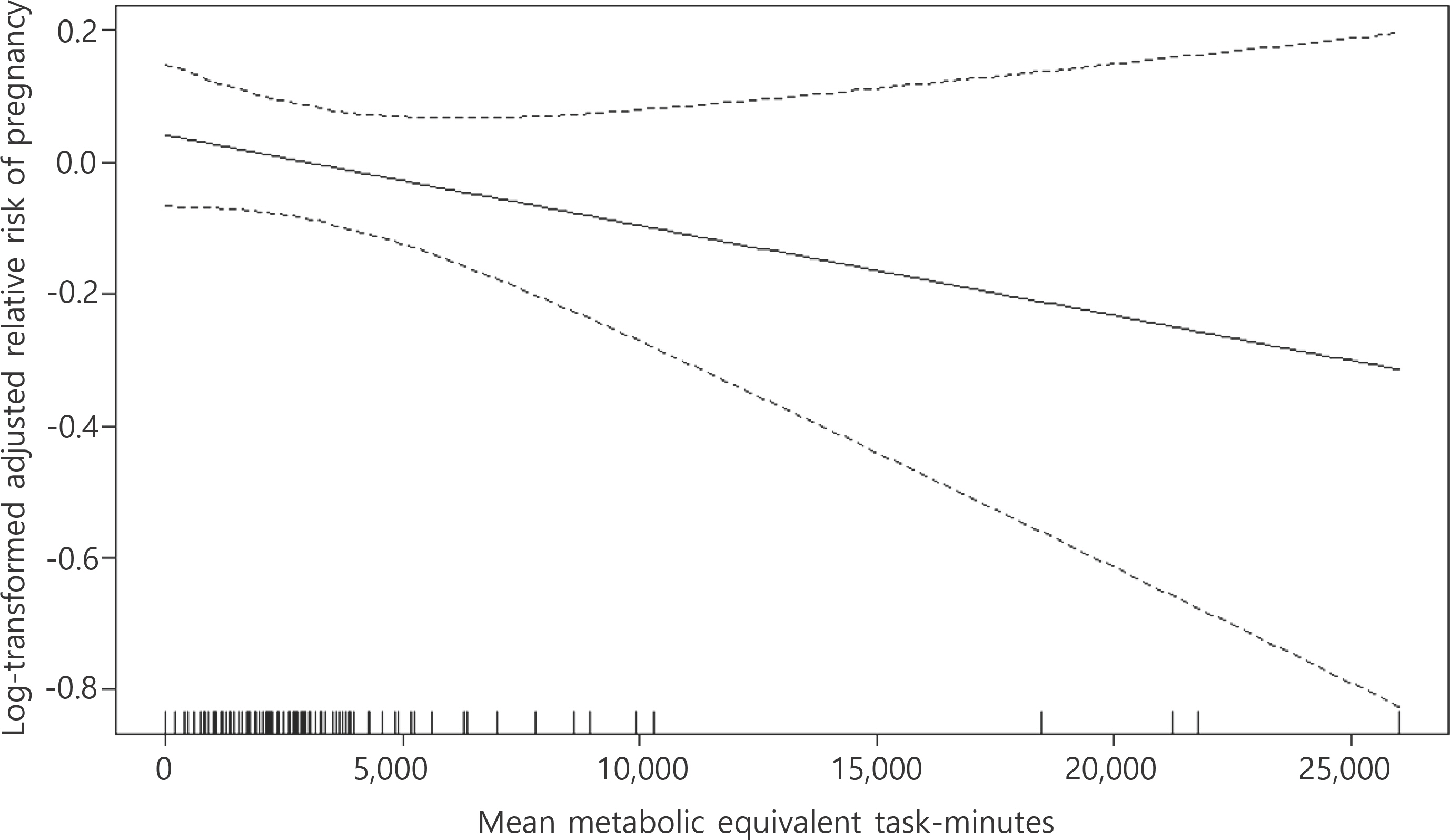J Korean Soc Matern Child Health.
2021 Apr;25(2):81-87. 10.21896/jksmch.2021.25.2.81.
Physical Activity and Successful Pregnancy in 6 Months: A Finding from the Pregnancy and Urban Environment Study
- Affiliations
-
- 1Major in Health Science, Graduate School of Health Industry, CHA University, Seongnam, Korea
- 2Department of Preventive Medicine, Korea University College of Medicine, Seoul, Korea
- 3CHA University School of Medicine, Seongnam, Korea
- KMID: 2515645
- DOI: http://doi.org/10.21896/jksmch.2021.25.2.81
Abstract
- Purpose
This study aimed to assess the association between physical activity and pregnancy in 6 months among infertile women who underwent in vitro fertilization (IVF).
Methods
The participants included in this study were infertile women who underwent IVF at Cha Fertility Center in Seoul Station from October 2019 to February 2020. Of 132 women who agreed to participate in the study, one was eliminated for omitting the exercise questionnaire. A survey assessing the level of physical activity of infertile women was conducted using the Korean version of the International Physical Activity Questionnaires. We calculated metabolic equivalent task-minutes (MET-min) scores and obtained their IVF results after 6 months of the survey. Participants with less than 3,000 MET-min were classified into the minimally active group, and those with ≥3,000 MET-min were classified as the healthenhancing group. The 2 groups were compared based on age, anti-Müllerian hormone levels, body mass index, infertility duration, nulliparity, harmful alcohol drinking, history of smoking, obesity, male factors, and pregnancy rates. Adjusted relative risk for pregnancy was calculated using log-binomial regression analysis.
Results
There was no significant difference in basal characteristics between the less active and health-enhancing groups. When controlling for all covariates, the relative risk for pregnancy was close to null with health-enhancing activity. The adjusted pregnancy rate decreased with increasing MET-min in the generalized additive model.
Conclusion
We observed no positive association between physical activity and pregnancy rate among interfile women undergoing IVF. To confirm our findings, subsequent interventional studies would be needed.
Figure
Cited by 2 articles
-
Factors Predicting afterward Childbirth for Infertile Women: The Intensity of Physical Activity
Kyueun Han, Min Young Kim
J Korean Soc Matern Child Health. 2021;25(3):197-203. doi: 10.21896/jksmch.2021.25.3.197.A Scoping Review of the Effect of the COVID-19 Pandemic on Patients Under Infertility Treatment
Boyoung Jeon, Hongbi Kim, Hye In Jeong
J Korean Soc Matern Child Health. 2023;27(2):80-91. doi: 10.21896/jksmch.2023.27.2.80.
Reference
-
An Y., Sun Z., Li L., Zhang Y., Ji H. Relationship between psychological stress and reproductive outcome in women undergoing in vitro fertilization treatment: psychological and neurohormonal assessment. J Assist Reprod Genet. 2013. 30:35–41.
ArticleBoivin J., Bunting L., Collins JA., Nygren KG. International estimates of infertility prevalence and treatment-seeking: potential need and demand for infertility medical care. Hum Reprod. 2007. 22:1506–12.
ArticleChaput JP., Ferraro ZM., Prud–homme D., Sharma AM. Widespread misconceptions about obesity. Can Fam Physician. 2014. 60:973–5.Cleland C., Ferguson S., Ellis G., Hunter RF. Validity of the International Physical Activity Questionnaire (IPAQ) for assessing moderate-to-vigorous physical activity and sedentary behaviour of older adults in the United Kingdom. BMC Med Res Methodol. 2018. 18:176.
ArticleCraig CL., Marshall AL., Sjøstrøm M., Bauman AE., Booth ML., Ainsworth BE, et al. International physical activity questionnaire: 12-country reliability and validity. Med Sci Sports Exerc. 2003. 35:1381–95.
ArticleDağ ZØ., Dilbaz B. Impact of obesity on infertility in women. J Turk Ger Gynecol Assoc. 2015. 16:111–7.Ferraretti AP., La Marca A., Fauser BC., Tarlatzis B., Nargund G., Gianaroli L, et al. ESHRE consensus on the definition of “poor response” to ovarian stimulation for in vitro fertilization: the Bologna criteria. Hum Reprod. 2011. 26:1616–24.
ArticleHealthcare Bigdata Hub [Internet]. Wonju (Korea): Health Insurance Review & Assessment Service;[cited 2020 Jul 1]. Available from:. http://opendata.hira.or.kr.IPAQ Research Committee. Guidelines for data processing and analysis of the International Physical Activity Questionnaire (IPAQ)–Short and Long Forms [Internet]. International Physical Activity Questionnaire;2005 Nov. [cited 2019 Oct 20]. Available from:. http://www.ipaq.ki.se/dloads/IPAQ%20LS%20Scoring%20Protocols_Nov05.pdf.Lee PH., Macfarlane DJ., Lam TH., Stewart SM. Validity of the International Physical Activity Questionnaire Short Form (IPAQ-SF): a systematic review. Int J Behav Nutr Phys Act. 2011. 8:115.
ArticleLee YH., Park JS. Factors affecting the infertility-related quality of life among the infertility women. J Korean Soc Matern Child Health. 2019. 23:191–201.
ArticleMassey AJ., Campbell B., Raine-Fenning N., Aujla N., Vedhara K. The association of physiological cortisol and IVF treatment outcomes: a systematic review. Reprod Med Biol. 2014. 13:161–76.
ArticleMastorakos G., Pavlatou M. Exercise as a stress model and the interplay between the hypothalamus-pituitary-adrenal and the hypothalamus-pituitary-thyroid axes. Horm Metab Res. 2005. 37:577–84.
ArticleMendes MA., da Silva I., Ramires V., Reichert F., Martins R., Ferreira R, et al. Metabolic equivalent of task (METs) thresholds as an indicator of physical activity intensity. PLoS One. 2018. 13:e0200701.
ArticleOh JY., Yang YJ., Kim BS., Kang JH. Validity and Reliability of Korean Version of International Physical Activity Questionnaire (IPAQ) Short Form. J Korean Acad Fam Med. 2007. 28:532–41.Smith RL., Vernon KL., Kelley DE., Gibbons JR., Mortensen CJ. Impact of moderate exercise on ovarian blood flow and early embryonic outcomes in mares. J Anim Sci. 2012. 90:3770–7.Trevor H., Tibshirani R. Generalized additive models. Stat Sci. 1986. 2:297–310.Zain MM., Norman RJ. Impact of obesity on female fertility and fertility treatment. Womens Health (Lond). 2008. 4:183–94.
Article
- Full Text Links
- Actions
-
Cited
- CITED
-
- Close
- Share
- Similar articles
-
- Associations between Social and Physical Environments, and Physical Activity in Adults from Urban and Rural Regions
- A case of heterotopic pregnancy
- Successful Pregnancy Outcome in a Patient with Untreated Wilson`s Disease : A Case Report
- Successful laparoscopic treatment of an omental pregnancy
- A Case of Advanced Tubal Pregnancy


